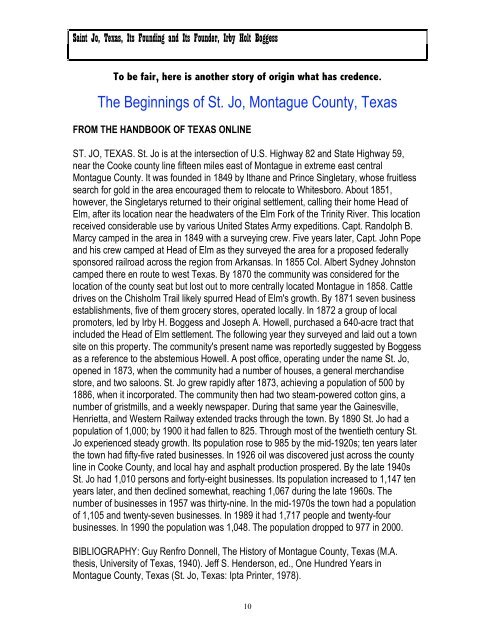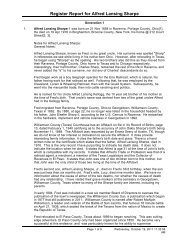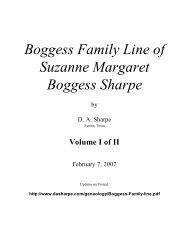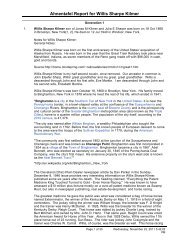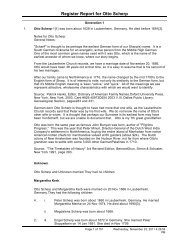The Saga of Irby Holt Boggess & his founding of St. Jo ... - D. A. Sharpe
The Saga of Irby Holt Boggess & his founding of St. Jo ... - D. A. Sharpe
The Saga of Irby Holt Boggess & his founding of St. Jo ... - D. A. Sharpe
Create successful ePaper yourself
Turn your PDF publications into a flip-book with our unique Google optimized e-Paper software.
Saint <strong>Jo</strong>, Texas, Its Founding and Its Founder, <strong>Irby</strong> <strong>Holt</strong> <strong>Boggess</strong><br />
To be fair, here is another story <strong>of</strong> origin what has credence.<br />
<strong>The</strong> Beginnings <strong>of</strong> <strong>St</strong>. <strong>Jo</strong>, Montague County, Texas<br />
FROM THE HANDBOOK OF TEXAS ONLINE<br />
ST. JO, TEXAS. <strong>St</strong>. <strong>Jo</strong> is at the intersection <strong>of</strong> U.S. Highway 82 and <strong>St</strong>ate Highway 59,<br />
near the Cooke county line fifteen miles east <strong>of</strong> Montague in extreme east central<br />
Montague County. It was founded in 1849 by Ithane and Prince Singletary, whose fruitless<br />
search for gold in the area encouraged them to relocate to Whitesboro. About 1851,<br />
however, the Singletarys returned to their original settlement, calling their home Head <strong>of</strong><br />
Elm, after its location near the headwaters <strong>of</strong> the Elm Fork <strong>of</strong> the Trinity River. T<strong>his</strong> location<br />
received considerable use by various United <strong>St</strong>ates Army expeditions. Capt. Randolph B.<br />
Marcy camped in the area in 1849 with a surveying crew. Five years later, Capt. <strong>Jo</strong>hn Pope<br />
and <strong>his</strong> crew camped at Head <strong>of</strong> Elm as they surveyed the area for a proposed federally<br />
sponsored railroad across the region from Arkansas. In 1855 Col. Albert Sydney <strong>Jo</strong>hnston<br />
camped there en route to west Texas. By 1870 the community was considered for the<br />
location <strong>of</strong> the county seat but lost out to more centrally located Montague in 1858. Cattle<br />
drives on the C<strong>his</strong>holm Trail likely spurred Head <strong>of</strong> Elm's growth. By 1871 seven business<br />
establishments, five <strong>of</strong> them grocery stores, operated locally. In 1872 a group <strong>of</strong> local<br />
promoters, led by <strong>Irby</strong> H. <strong>Boggess</strong> and <strong>Jo</strong>seph A. Howell, purchased a 640-acre tract that<br />
included the Head <strong>of</strong> Elm settlement. <strong>The</strong> following year they surveyed and laid out a town<br />
site on t<strong>his</strong> property. <strong>The</strong> community's present name was reportedly suggested by <strong>Boggess</strong><br />
as a reference to the abstemious Howell. A post <strong>of</strong>fice, operating under the name <strong>St</strong>. <strong>Jo</strong>,<br />
opened in 1873, when the community had a number <strong>of</strong> houses, a general merchandise<br />
store, and two saloons. <strong>St</strong>. <strong>Jo</strong> grew rapidly after 1873, achieving a population <strong>of</strong> 500 by<br />
1886, when it incorporated. <strong>The</strong> community then had two steam-powered cotton gins, a<br />
number <strong>of</strong> gristmills, and a weekly newspaper. During that same year the Gainesville,<br />
Henrietta, and Western Railway extended tracks through the town. By 1890 <strong>St</strong>. <strong>Jo</strong> had a<br />
population <strong>of</strong> 1,000; by 1900 it had fallen to 825. Through most <strong>of</strong> the twentieth century <strong>St</strong>.<br />
<strong>Jo</strong> experienced steady growth. Its population rose to 985 by the mid-1920s; ten years later<br />
the town had fifty-five rated businesses. In 1926 oil was discovered just across the county<br />
line in Cooke County, and local hay and asphalt production prospered. By the late 1940s<br />
<strong>St</strong>. <strong>Jo</strong> had 1,010 persons and forty-eight businesses. Its population increased to 1,147 ten<br />
years later, and then declined somewhat, reaching 1,067 during the late 1960s. <strong>The</strong><br />
number <strong>of</strong> businesses in 1957 was thirty-nine. In the mid-1970s the town had a population<br />
<strong>of</strong> 1,105 and twenty-seven businesses. In 1989 it had 1,717 people and twenty-four<br />
businesses. In 1990 the population was 1,048. <strong>The</strong> population dropped to 977 in 2000.<br />
BIBLIOGRAPHY: Guy Renfro Donnell, <strong>The</strong> History <strong>of</strong> Montague County, Texas (M.A.<br />
thesis, University <strong>of</strong> Texas, 1940). Jeff S. Henderson, ed., One Hundred Years in<br />
Montague County, Texas (<strong>St</strong>. <strong>Jo</strong>, Texas: Ipta Printer, 1978).<br />
10


